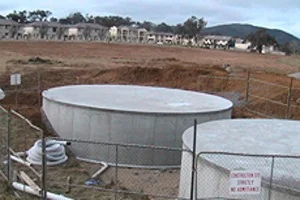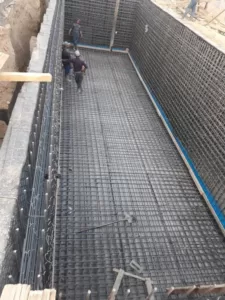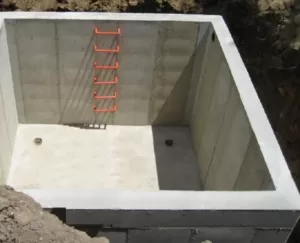
1.Underground Tank Waterproofing | UG Sump – importance
Waterproofing an underground water tank from both the inside and outside is essential to ensure maximum protection against water infiltration and leakage.
Waterproofing the tank from the inside ensures that the water stored in the tank remains safe and free from any contamination. It also prevents leaks from the inside of the tank, which can lead to water damage and structural problems. Additionally, the internal waterproofing layer can prevent the tank from corroding due to the chemical reaction of water with the tank material.
On the other hand, waterproofing the tank from the outside prevents water from infiltrating into the tank through the surrounding soil and groundwater. This protects the tank structure from the damaging effects of water and ensures the longevity of the tank. It also prevents leaks from the outside, which can lead to water damage and structural issues.
2. Underground Tank Waterproofing | UG Sump Waterproofing
The process of waterproofing an underground water tank from both the inside and outside during construction typically involves the following steps:
- Excavation: Excavate the hole for the water tank according to the design specifications.
- Foundation: Build the foundation of the tank with a proper slope for drainage and to prevent water accumulation.
- External waterproofing over PCC: Apply a waterproofing membrane or coating on the PCC. The material should be resistant to chemical attack, UV degradation, and physical damage to ensure long-term protection.
- Construct the tank: Build the walls of the tank with suitable materials and design it to withstand the hydrostatic pressure of the soil and groundwater. The tank should be constructed with proper joints and seals.
- Internal waterproofing: Apply a waterproofing coating or lining on the interior surface of the tank. The coating should be chemical resistant and durable to ensure long-term protection.
- External waterproofing: Apply a waterproofing membrane or coating on the exterior surface of the tank. The material should be resistant to chemical attack, UV degradation, and physical damage to ensure long-term protection.
- Backfilling: Fill the gap between the tank and the surrounding soil with suitable material and ensure proper compaction to prevent settlement.
- Installation of accessories: Install accessories such as inlet, outlet, overflow, ventilation, and other pipes as per the design specifications.
- Final inspection: Conduct a final inspection of the tank to ensure that it meets the design specifications and quality standards.


3. selection of Underground Tank Waterproofing | UG Sump system
When selecting a waterproofing system for the external walls and PCC (plain cement concrete) of an underground tank or sump, several factors should be considered, such as the type of soil, groundwater level, and the site’s environmental conditions. The following are some popular types of waterproofing systems that can be used for external walls and PCC of an underground tank or sump:
- Bituminous membranes: Bituminous membranes such as APP and SBS are also commonly used for waterproofing external walls and PCC. They are easy to apply and can provide excellent protection against water infiltration and chemical attack.
- HDPE membranes: Various types of HDPE membranes are also used for waterproofing external walls and PCC. They are easy to apply and can provide excellent protection against water infiltration and chemical attack.
- Cystallisation System: Crystallisation systems are another type of waterproofing system that can be used for external walls and PCC of underground water tanks. The system works by forming insoluble crystals within the concrete structure, blocking the capillaries and pores of the concrete to prevent water infiltration.
- Cementitious coatings: Cementitious coatings are a popular choice for waterproofing PCC surfaces. They can provide excellent protection against water infiltration, chemical attack, and abrasion.
- Polyurethane membranes: Polyurethane membranes are a popular choice for waterproofing external walls and PCC. They are easy to apply, can conform to the surface, and provide excellent protection against water infiltration and chemical attack.
- Hybrid system: A combination of systems given above are also used in certain cases.
When selecting a waterproofing system for external walls and PCC, it’s essential to choose a system that is suitable for the site’s environmental conditions, can withstand the soil’s properties, and provide long-term protection against water infiltration and leakage. It’s also important to choose a system that is installed by a reputable and experienced waterproofing contractor.
GEOLIZ WATERPROOFERS PVT. LTD.
Waterproofing Products & Services Guide
For details on other waterproofing products & Services
